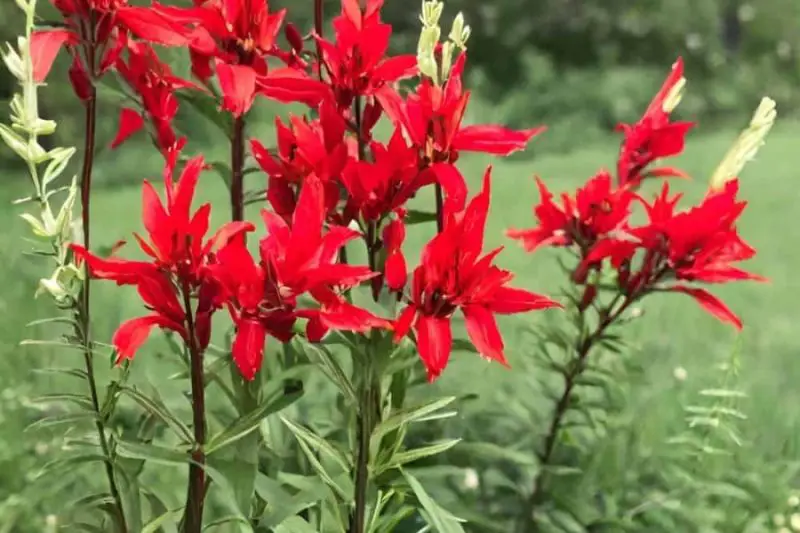Cardinal flower is one of the most striking native perennials, known for its brilliant red blooms that light up summer gardens. Its vibrant color not only captures the eye but also draws hummingbirds and pollinators, making it a centerpiece in any landscape. Understanding when this flower blooms is key for gardeners who want to enjoy its full beauty and ecological benefits.
Blooming at just the right moment, the cardinal flower offers weeks of color during the warm season, creating a spectacular show from midsummer to early fall. By learning about its seasonal cycle and care requirements, gardeners can plan ahead for longer-lasting displays and healthier plants. This guide will walk you through everything you need to know about the blooming season and how to make the most of it.
Understanding Cardinal Flower Blooming Season

The cardinal flower is a native North American perennial that captures attention with its vibrant scarlet red blooms. Gardeners value it not only for its beauty but also for its role in attracting hummingbirds and pollinators. To grow it successfully, it is important to understand its natural blooming season. This helps ensure proper care and preparation for vibrant flowers. The life cycle of the plant follows a predictable rhythm each year, which can guide gardeners in planning their landscapes effectively.
Cardinal flowers typically bloom in the warm summer months, with most regions experiencing blossoms from mid-July through September. The exact timing depends on local climate, daylight length, and growing conditions. In cooler northern areas, the flowering season may begin later, while southern regions often enjoy earlier displays. These flowers thrive in consistently moist soils, which encourage them to reach their peak bloom during the height of summer. Understanding the timing of bloom is essential not just for aesthetic planning but also for ensuring pollinators find a reliable food source when they need it most.
Recognizing this seasonal rhythm allows gardeners to plan their landscapes for continuous color. By pairing cardinal flowers with early or late blooming species, one can achieve a balanced garden display that lasts from spring through fall. Proper timing also helps in scheduling pruning, watering, and fertilization for optimal results. With the right preparation, the vibrant red flowers can be enjoyed at their fullest, turning an ordinary garden into a spectacular seasonal showcase. For gardeners who love color and wildlife activity, knowing when the cardinal flower blooms is a valuable key to success.
Regional Blooming Differences
Northern Climates
In northern climates, where winters are long and spring is slow to arrive, cardinal flowers usually start blooming in late July or early August. The shorter growing season delays their development compared to warmer regions. Gardeners in these zones should be patient, as the plants often focus on establishing strong root systems before producing flowers. The cooler start also means plants devote much of their early energy to foliage before producing their vivid red blossoms. This rhythm is natural and ensures that the flowers will be healthy and robust once they open.
Cooler summers also mean blooms may last slightly longer, extending into September or even early October if frost arrives late. This prolonged display is a reward for gardeners who maintain moist soil conditions during the drier summer months. Consistent mulching and watering during warm spells can make a significant difference in extending bloom life. By ensuring reliable care and avoiding drought stress, the flowers can reach their full potential and create a striking visual impact in northern gardens year after year.
Southern Climates
In southern climates, cardinal flowers benefit from longer growing seasons and warmer temperatures. They often begin flowering as early as late June or early July, continuing through August. The earlier bloom period provides more opportunities for pollinators such as hummingbirds, butterflies, and bees. The long days and high light intensity encourage vigorous growth, which helps the plants achieve taller stems and fuller flower spikes than in cooler zones.
However, the intense summer heat can shorten the flowering duration if moisture is not consistently available. Gardeners in the south should focus on providing shade during the hottest part of the day and ensuring reliable watering. Adding organic matter to the soil also improves water retention and keeps roots cooler. These practices help extend the blooming season and keep the plants healthy and vibrant for longer periods, allowing southern gardens to enjoy brilliant red flowers despite challenging summer conditions.
Environmental Factors Affecting Bloom Time
Temperature Influence
Temperature plays a critical role in determining when cardinal flowers bloom. Warm, consistent temperatures in late spring and early summer signal the plants to transition from vegetative growth to flowering. Sudden temperature fluctuations, such as unexpected heat waves or cold spells, can delay or reduce blooming. Extended periods of cold can keep the plant in a dormant state longer, while extreme heat may force it to conserve energy rather than produce flowers. For this reason, gardeners must understand how regional climate patterns shape the performance of these plants.
In cooler regions, gradual warming helps ensure strong flower development. In contrast, rapid temperature changes in warmer areas may cause stress and shorten bloom duration. Monitoring local weather patterns allows gardeners to adjust care practices, such as providing mulch to stabilize soil temperature and reduce stress on plants. Shading during heat waves and avoiding exposure to harsh afternoon sun also help minimize environmental stress. By protecting plants from extremes, gardeners encourage longer, more vibrant blooming seasons regardless of location.
Soil and Moisture Conditions
Cardinal flowers naturally thrive in moist, fertile soils often found along streambanks or wetlands. Consistent moisture is essential for initiating and sustaining blooms. If the soil dries out too quickly, the plants may struggle to produce flowers or their blooming period may be cut short. Poor drainage can also harm roots, reducing the plant’s ability to absorb nutrients and water efficiently. Maintaining the right balance of wet but not waterlogged soil is key to supporting healthy growth and full flowering.
Gardeners can recreate these conditions by choosing planting sites with rich organic matter and ensuring adequate irrigation. Mulching also helps retain soil moisture during hot summers. Adding compost or leaf mold improves soil fertility, while drip irrigation provides steady hydration without waterlogging. By maintaining these conditions, the plants can bloom fully and attract pollinators throughout their peak season. With the right soil care, cardinal flowers will reward gardeners with reliable, brilliant red blossoms each summer.
Companion Planting for Extended Bloom
Early Bloom Companions
Pairing cardinal flowers with early-blooming plants helps maintain garden beauty long before the tall red spikes emerge. Native species such as columbine, wild phlox, and Virginia bluebells begin flowering in late spring, adding soft hues of blue, purple, and pink. These blossoms not only fill the visual gap but also provide nectar sources for early-season pollinators like hummingbirds and bees. By establishing a progression of bloom, the garden remains vibrant and productive instead of experiencing a lull before midsummer.
Beyond ecological value, early bloom companions enhance garden structure by offering layered textures and colors. The delicate forms of columbine or the airy look of phlox contrast with the bold, upright growth of cardinal flowers. This intentional pairing highlights the later summer display even more dramatically, as the eye transitions from the lighter spring tones to the rich scarlet flowers. For gardeners, this strategy creates a living tapestry that evolves over time, ensuring the garden remains visually dynamic while also functioning as a vital resource for wildlife from early spring onward.
Late Bloom Companions
Introducing late-blooming companions ensures that garden interest continues after the cardinal flowers reach their peak. Plants such as goldenrod, New England asters, and Joe-Pye weed extend the color palette into fall with striking yellows, purples, and pinks. These species thrive in similar moist conditions, making them natural partners for cardinal flowers. As the red blossoms fade in late summer, these companions carry the garden’s beauty seamlessly into the next season, preventing abrupt declines in visual appeal.
In addition to aesthetics, late bloom companions play a crucial role in supporting pollinators. Monarch butterflies, migrating hummingbirds, and native bees rely on these late-season flowers for energy reserves before cooler weather sets in. By planning for overlapping bloom periods, gardeners can create a pollinator-friendly environment that functions as an ecological bridge from summer to autumn. This design approach transforms the garden into a continuous source of color and life, blending beauty with biodiversity and ensuring that every stage of the growing season offers both visual rewards and environmental benefits.
Midseason Companions
Cardinal flower begins to bloom in mid to late summer, often overlapping with other perennials that thrive during the same period. Pairing it with plants that flower around midsummer creates a balanced and colorful display that lasts for several weeks. Gardeners often choose black-eyed Susans, coneflowers, and bee balm as excellent midseason companions. Their bold colors and upright growth blend beautifully with the deep red spikes of cardinal flowers, creating layers of visual interest in the garden. Beyond aesthetics, this combination supports a variety of pollinators by offering multiple nectar sources during the warmest part of the season.
Another advantage of midseason companions lies in the way they enhance the ecological role of the cardinal flower. While the bright red blooms attract hummingbirds, plants like bee balm and coneflowers also draw butterflies and bees. This overlap creates a thriving pollinator hub that benefits the entire garden ecosystem. Pairing midseason bloomers with cardinal flowers also helps fill gaps in the landscape, ensuring continuous bursts of color. For gardeners looking to design a pollinator-friendly and visually striking garden, combining cardinal flowers with strong midseason companions is a simple yet rewarding strategy.
Caring for Cardinal Flowers to Maximize Bloom
Watering Needs
Cardinal flowers flourish when their soil remains evenly moist, making watering one of the most important care tasks. Unlike many ornamental plants that can tolerate periods of dryness, cardinal flowers struggle without a consistent water source. During the heat of summer, rainfall alone often cannot sustain them, so supplemental watering becomes essential. Gardeners should monitor soil conditions closely, especially during extended warm spells, to prevent wilting or stunted growth.
The method of watering also plays a crucial role. Deep watering, which soaks the soil several inches down, encourages roots to grow stronger and more resilient. This helps the plant withstand short dry periods and fluctuating summer temperatures. Applying a layer of mulch around the base locks in moisture and protects roots from overheating. By combining deep watering with mulching, gardeners create an environment that promotes continuous and healthy blooming throughout the growing season.
Fertilization Practices
Fertilizing at the right time enhances the cardinal flower’s ability to produce its signature vibrant blooms. Early summer, just before flower spikes begin to emerge, is the ideal period to apply nutrients. A balanced, slow-release fertilizer or organic compost works best, providing steady nourishment without overwhelming the plant. This gradual feeding approach ensures the flowers reach their peak color and longevity while maintaining overall plant health.
Excessive fertilizer, especially those high in nitrogen, can encourage leafy growth at the expense of flowers. To avoid this, gardeners should prioritize natural soil amendments that enrich the earth without overstimulating growth. Adding compost improves soil texture, increases nutrient content, and promotes microbial activity, all of which support stronger flowering. A careful balance of nutrition not only maximizes bloom production but also helps the plant remain vigorous for years to come.
Bloom Duration and Deadheading
Typical Bloom Length
Cardinal flowers typically bloom from mid to late summer, creating a striking vertical accent in gardens or naturalized landscapes. The flowers open progressively from the bottom of the spike upward, meaning the overall display can appear longer than the life of each individual bloom. In cool, moist environments such as shaded stream banks, the flowering season can stretch closer to six weeks, offering an extended burst of vibrant red that attracts pollinators like hummingbirds and butterflies. The gradual opening of the blossoms ensures that the plant provides a continuous nectar source during this critical time.
In hotter regions or when soil dries out quickly, the flowering duration is usually shorter, often closer to four weeks. Stress from heat or lack of water accelerates flower fading and shortens the overall display. Mulching around the base and ensuring consistent watering can help maintain soil moisture and keep the plant blooming longer. By mimicking natural habitats and reducing plant stress, gardeners can reliably extend the bloom season and enjoy the plant’s ornamental and ecological value to its fullest.
Deadheading for Prolonged Blooms
Deadheading is especially useful for gardeners who want to maintain a neat and colorful garden throughout the summer season. Removing faded blooms prevents the plant from prematurely directing its resources toward seed production. Instead, the energy is redirected into creating additional flowers, resulting in a longer-lasting show. The process is simple: use sharp scissors or pruners to snip off spent flowers just above a set of healthy leaves, being careful not to damage emerging buds or foliage. This practice not only enhances the plant’s vitality but also reduces the risk of fungal infections that sometimes develop on decaying blossoms.
In addition to extending the flowering season, deadheading improves the plant’s overall appearance, ensuring the flower spikes look fresh and well-maintained. Although cardinal flowers are short-lived perennials, regular deadheading can significantly extend their seasonal contribution. Gardeners who prefer natural reseeding may choose to leave a portion of the flower spikes intact toward the end of the season. This balance allows the plant to reproduce naturally while still enjoying an extended and vibrant floral display earlier in the summer.
Wildlife Interaction During Bloom
Attracting Pollinators
The brilliant red blossoms of cardinal flowers are a magnet for hummingbirds, whose long beaks and rapid wingbeats allow them to access the nectar hidden deep inside the tubular petals. This natural pairing is a perfect example of co-evolution, as the flower depends on the hummingbird for pollination while the bird gains a reliable food source during the summer months. Bees, butterflies, and even moths are also drawn to the nectar, though the flower’s shape gives hummingbirds a unique advantage. Their frequent visits ensure that the pollen is efficiently transferred, keeping the plant’s reproductive cycle strong.
In the garden, these lively interactions add both beauty and purpose. Watching hummingbirds darting from flower to flower creates a sense of movement and vibrancy that few plants can match. Gardeners who plant cardinal flowers not only enjoy their ornamental appeal but also play a direct role in sustaining local pollinator populations. Each bloom contributes to a thriving ecosystem, turning a simple flower bed into a dynamic and life-filled habitat.
Supporting Biodiversity
Cardinal flowers are more than just a striking garden feature; they are a lifeline for wildlife during times when nectar is less abundant. Blooming in late summer, these plants provide vital energy to pollinators preparing for seasonal changes. Migrating butterflies, in particular, benefit from the nectar as they gather strength for long journeys southward. The extended bloom period of cardinal flowers bridges a crucial gap in food supply, supporting a wide range of species.
By including cardinal flowers in a landscape, gardeners actively promote biodiversity. Their presence encourages a greater diversity of insects and birds, which in turn supports healthy soil, pest control, and plant pollination. This interconnected cycle strengthens the entire ecosystem, from tiny soil organisms to larger wildlife. For the gardener, the reward is both practical and emotional: a thriving, balanced environment that is visually stunning and ecologically valuable. Each flower is a small contribution to a larger network that sustains nature’s delicate balance.
Seasonal Maintenance After Bloom
Deadheading and Seed Management
After the cardinal flower finishes blooming, one of the most effective care practices is deadheading. Removing spent flowers helps maintain the plant’s appearance and directs its energy toward root and foliage health rather than seed development. For gardeners who want a tidier look or wish to extend the bloom period slightly, this step can make a visible difference. However, if natural reseeding is desired, leaving some flowers to form seed pods will allow new plants to emerge the following spring.
Seed management plays an important role in long-term growth. Collecting seeds gives gardeners control over where new plants establish, preventing unwanted spreading while encouraging propagation in chosen areas. Properly dried seeds can be stored and sown the next season to expand garden beds or share with other plant enthusiasts. By deciding between deadheading and seed saving, gardeners can balance beauty and sustainability, ensuring healthy cardinal flower populations for years.
Cutting Back Foliage
Once the blooming season ends, the foliage of the cardinal flower gradually begins to decline. Cutting back the leaves and stems not only improves the garden’s appearance but also reduces the risk of disease and pests overwintering in the old growth. Trimming should be done carefully, leaving a small portion of basal foliage intact so the plant can store energy for the following growing season.
This maintenance step also supports healthier regrowth in spring. By reducing plant stress and eliminating potential hiding places for insects, the cardinal flower is better prepared to thrive the next year. Gardeners who incorporate seasonal cutting back as part of their routine will find their plants stronger and more vibrant. The process ensures that the plant completes its natural cycle while remaining a consistent highlight in pollinator-friendly gardens.
Soil and Mulch Care After Bloom
After the blooming season ends, caring for the soil and mulch around cardinal flowers is essential for maintaining their long-term health. The soil should remain consistently moist but not waterlogged, which means regular monitoring is necessary, especially during hot or dry spells. After blooming, nutrients in the soil may be depleted, so lightly working in organic compost or a balanced slow-release fertilizer can help restore fertility. This ensures the plant has the resources needed to strengthen its root system before entering dormancy. Improving soil quality at this stage sets the foundation for vigorous growth and more vibrant flowers in the following season.
Mulching plays a critical role in protecting the soil and conserving moisture after bloom. A layer of organic mulch, such as shredded bark or leaf mold, helps regulate temperature, reduce evaporation, and suppress weeds that compete for nutrients. As the plant shifts its energy toward root development, mulch keeps the soil environment stable and less prone to erosion. Over time, organic mulch also breaks down and enriches the soil naturally. Refreshing or replacing mulch after the bloom period supports healthier conditions, ensuring the cardinal flower thrives year after year with minimal stress.
Pest and Disease Monitoring After Bloom
Once the blooming period of cardinal flowers comes to an end, the plant enters a stage where it becomes more vulnerable to stress factors such as pests and diseases. At this time, the fading blooms and shifting energy in the plant can attract aphids, slugs, and spider mites, which feed on tender foliage and weaken the plant. Fungal diseases such as powdery mildew and leaf spot may also appear, particularly if humidity levels remain high or air circulation is poor. Regularly inspecting the plant, especially the underside of leaves and lower stems, is an effective way to catch problems early. If pests are found, removing them by hand or using insecticidal soap helps protect the plant without harming beneficial insects like pollinators.
Preventive measures are equally important to maintain the long-term health of cardinal flowers after bloom. Cleaning up plant debris around the base discourages fungal spores and insects from overwintering in the soil. Applying a light layer of organic mulch can also suppress pests while keeping the soil environment stable. If fungal issues persist, using a fungicide approved for ornamental plants may be necessary, but ensuring proper watering practices and spacing between plants often reduces outbreaks naturally. By staying alert and proactive during this post-bloom stage, gardeners ensure that their cardinal flowers remain strong and ready to produce vibrant blooms in the following year.
Dividing and Transplanting Cardinal Flowers
As cardinal flowers mature, their clumps often grow denser, which can reduce overall vigor and flowering performance. Dividing the plants after they finish blooming helps rejuvenate growth and prevents overcrowding. This process also gives gardeners an opportunity to propagate new plants for other areas of the garden. Early fall is the best time for division, as the soil is still warm, giving roots a chance to establish before winter dormancy. Carefully lifting the clump with a spade and gently separating the offsets ensures minimal root damage and a higher survival rate.
Once divided, replant the sections immediately in moist, fertile soil enriched with organic matter to support healthy establishment. Spacing the transplants properly allows for airflow and reduces the risk of fungal diseases, which cardinal flowers are prone to in damp environments. Adding mulch around the base helps retain soil moisture while keeping roots cool. Regular watering after transplanting is essential, especially during dry spells, until the plants are well-rooted. By dividing and replanting cardinal flowers thoughtfully, you not only extend their lifespan but also create more vibrant displays throughout your garden.
Mistakes to Avoid and How to Solve
Overwatering and Root Problems
One of the most common mistakes when growing cardinal flowers is giving them too much water in poorly drained soil. While these plants thrive in moist conditions, waterlogged soil can lead to root rot and fungal diseases that quickly weaken or kill the plant. Signs of overwatering include yellowing leaves, stunted growth, and a soggy base around the roots. Gardeners often confuse cardinal flowers’ preference for moisture with a need for constant saturation, which can create more harm than good.
To solve this issue, it is important to maintain evenly moist soil while ensuring proper drainage. Raised beds or adding organic matter can help prevent water from stagnating around the roots. Gardeners should also monitor rainfall and reduce supplemental watering during particularly wet periods. If plants already show root problems, removing damaged sections and replanting in a healthier location can revive growth. With careful adjustments, you can provide the consistent moisture cardinal flowers need without exposing them to harmful excess water.
Planting in Excessive Shade
Another mistake many gardeners make is planting cardinal flowers in deep shade, which can limit both their growth and flowering potential. Although they tolerate partial shade, especially in hot climates, too little sunlight results in fewer blooms and weaker stems. Shade-grown plants often stretch unnaturally toward light, creating a leggy and fragile appearance. This lack of sunlight also reduces the plant’s ability to produce energy through photosynthesis, leaving it more vulnerable to pests and diseases.
The solution lies in finding the right balance of sun exposure. Cardinal flowers perform best in locations with full morning sun and light afternoon shade. If a plant is already struggling in deep shade, carefully transplanting it to a sunnier site in early spring or after blooming can make a big difference. For gardeners in warmer regions, providing dappled shade during peak afternoon heat prevents stress while still ensuring strong flower development. By observing how your plants respond to light and adjusting placement, you can encourage robust growth and abundant blooms.
Neglecting Deadheading and Pruning
Failing to deadhead and prune cardinal flowers after their bloom cycle is a mistake that can limit their longevity and beauty. When spent flowers are left on the plant, energy is diverted into seed production instead of supporting continued growth. This often shortens the blooming season and results in a less tidy appearance. In addition, unpruned stems can become overly crowded, restricting airflow and increasing the risk of fungal issues. Gardeners who skip this maintenance may find their plants declining sooner than expected.
To fix this, regular deadheading is key. Removing faded flower spikes encourages new blooms and keeps the plant looking fresh. At the end of the season, cutting back stems helps prepare the plant for winter and reduces the spread of disease. Using clean, sharp tools ensures that cuts heal quickly without stressing the plant. For gardeners who wish to collect seeds, selective deadheading can be practiced—leaving a few stalks for seed formation while removing the rest. By maintaining this simple routine, you ensure healthier plants and longer-lasting displays of cardinal flowers.
FAQ about Cardinal Flowers
How often should I water cardinal flowers during the growing season?
Cardinal flowers thrive in consistently moist soil, so watering is needed regularly, especially during hot, dry periods. Aim to keep the soil damp but not waterlogged. If grown near ponds or streams, they may need less supplemental watering since natural conditions maintain moisture levels.
Can cardinal flowers grow in containers successfully?
Yes, cardinal flowers can be grown in containers if provided with rich, moisture-retentive soil and consistent watering. Choose a deep pot with good drainage to prevent root rot. Position the container in partial sun, and remember that container plants dry out faster, so check moisture frequently.
Do cardinal flowers attract specific pollinators?
Cardinal flowers are particularly attractive to hummingbirds due to their bright red blooms and tubular shape. They also draw in butterflies and bees, adding life and activity to your garden. Planting them in groups enhances their visibility, making them even more appealing to pollinators throughout the summer season.
When should I cut back cardinal flowers after blooming?
Cutting back should be done in late fall or early spring once the flowers have faded and seeds have dispersed. Trim spent stems to encourage healthy growth and prevent diseases. However, leave some seed heads if you want natural reseeding, which ensures fresh plants appear the following season.
What common problems should I watch for with cardinal flowers?
Cardinal flowers are generally hardy but may face issues like root rot from poorly drained soil, slugs feeding on young leaves, or powdery mildew in humid areas. Regular monitoring, proper spacing, and keeping soil moist but well-drained will help prevent these problems and keep plants thriving year after year.
Conclusion
Cardinal flowers are a striking addition to any garden, offering bold colors and rich ecological value. Understanding their bloom season allows gardeners to plan effectively for continuous beauty. By providing the right conditions and care, one can enjoy vibrant displays from midsummer into early fall.
With proper maintenance and companion planting, the garden remains alive with color and pollinators throughout the growing season. The cardinal flower’s charm lies not only in its brilliant red blossoms but also in the life it brings to the landscape. Each season becomes more rewarding when gardeners embrace the natural rhythm of this unique plant.






